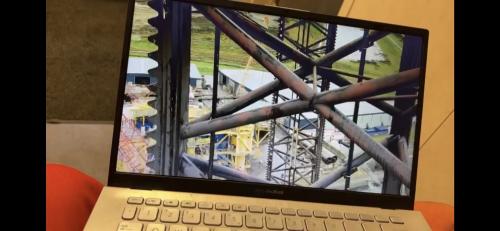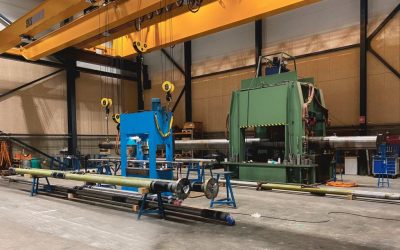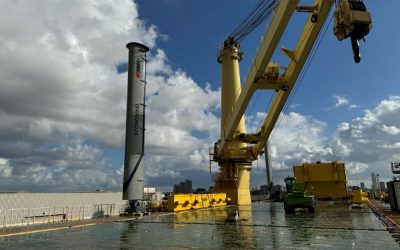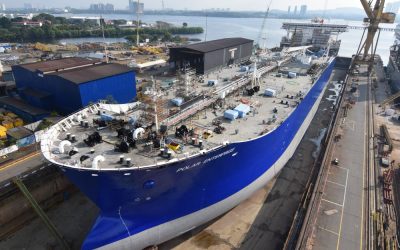Global Drone Inspection (GDI), a spin-off service offered by RIMS BV, has over the past year continued to develop innovative technical solutions to facilitate and enhance remote surveys and inspections. In particular, the company has been experimenting with unmanned aerial vehicles (UAVs) and small ROVs, the latter to inspect ships underwater.
GDI CEO David Knukkel says: “The advantage of ROVs is that these inspections can be executed by one or two people pretty fast, without a complete diving team, and can provide quick inspections of the hull, propeller, shaft seal or other areas in case of suspected damages or class surveys. However, the disadvantage of ROV involvement with a class survey is that in many cases the clearances of the rudder and stern tube needs to be measured which still requires a diver.”
Last year GDI obtained class certification from RINa to carry out in-water surveys. This means it is now allowed to use a ROV in combination with a diver, a service it subcontracts as required.
GDI has also been working to enhance its aerial drone technology to extend capabilities for marine inspections. Most notably it is participating in an early adoption programme with the Swiss company Voliro which has developed a drone which can carry out thickness measurements.
Knukkel says: “At this stage we are using it for internal purposes only as we do not have the local flight permits required to fly outdoors, which are different for each country. But we are excited about the potential for applications such as onboard large tankers, some types of chemical tankers and bulk carriers.”
Some classification societies have already approved the combination of a remote inspection technique (RIT) and a non-destructive testing (NDT) approved service supplier to execute the thickness measurements with an unmanned aerial vehicle (UAV).
“We are now aligning with several NDT companies to get the calibration and operational requirements integrated in their procedures, so all requirements are met,” says Knukkel. “There are some significant potential advantages for shipowners and managers, as while rope access, cherry pickers or scaffolding still might be required in certain areas, the amount is dramatically reduced, leading to a decrease in safety risks, costs and time required.”
GDI continues to see strong demand for its services as an established and proven supplier of drone-based remote inspections. Recently for example it has been involved with the class survey of a naval vessel while in drydock, checking welds during integrity tests on 14 tanks in a routine inspection. Recently GDI also undertook a visual close-up survey of a large crane vessel, inspecting all sides of its columns and bracings.
Knukkel points out: “This inspection had many challenges as there was no GPS, and a lot of wind and magnetic interference. Nevertheless, we managed to complete the inspection in five days to the satisfaction of the surveyor.”
As drone technology becomes mature, and is widely accepted by clients, and ‘cowboys’ disappear and only qualified and experienced companies remain, the business case becomes stronger, GDI suggests, leading to stronger demand.
This is particularly the case for tankers, bulk carriers and offshore installations. Visual close-up surveys of chemical tankers by drone are now fairly routine, with pilots sitting on deck. Depending on the size of the tanks and type of survey, GDI can inspect between six to 10 tanks a day, and its work is fully certified by all major classification societies. The visual surveys are usually done before or at the beginning of a drydock to ensure there is enough time to prepare potential repairs.
Knukkel adds: “UAV technology is not the ultimate tool replacing all other methods, but is a great add-on that increases cost efficiency and safety dramatically. It is here to stay and I believe the business will grow over time as we continue our mission to explain people what we do and why and create partnerships with other companies.”
A challenge identified by Knukkel as the technology is more widely accepted is a potential shortage of pilots, requiring investments in training and especially in developing a flight simulator which enables pilots to be trained, flying in 3D models without physically using a drone and having a ship or storage tank in place. There is also he says a need to work on the “last bits and pieces of the puzzle”.
He concludes: “Drones must be able to take thickness measurements everywhere and must be able to inspect areas in semi-autonomous mode, while data and information flows must be optimised or automated. To help make progress in these areas, GDI is participating in an industry advisory group, giving input about operational requirements, legislation and field experience, which hopefully will eventually lead to drone products meeting all such technical requirements.”




